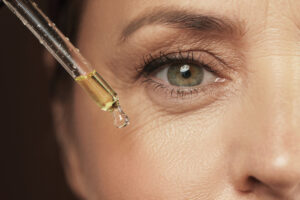What’s Your Age – a Story Told by Your Fingernails
When we think of aging, we instantly start thinking of loose skin, brittle hair, and very fragile bones. However, there’s one more thing that we should add to this list, and it is our nails. As time goes by, you might have noticed a series of changes to your nails’ texture, thickness, strength, and even an increased growth rate.
According to experts, all of these are total normal, and the wide majority of people might experience age-related nail changes by the time they reach 40. Even if these side effects of aging are quite inevitable, there’s way more you can do to manage them.
Now, we asked the opinion of some experts because we wanted to learn about all the different ways in which our nails change as we get older, but also gathered more tricks and tips on how to navigate them.

Nail texture and thickness
Have you noticed ridges on your nails? Well, this is often referred to as onychorrhexis, and it’s akin to wrinkles on the nail. When some parts of the nail growth plate (also known as the nail matrix) become thinner and even start to atrophy, the result is ridging (some sort of parallel longitudinal depressions in the nail plate).
There’s a wide number of things that can contribute to onychorrhexis, such as nutritional deficiencies and hormonal changes, but age is definitely a contributing factor.
As Dr. Michelle Henry, the founder of Skin and Aesthetic Surgery of Manhattan, explained, our nails can easily become brittle over time. This is due in large part to the degradation of the structural keratin proteins in the nails, which play a huge role in our nail health and protect against external damage.
The more we age, our bodies start to produce less of all the natural proteins found in nails, which can also lead to nails becoming more brittle and dry, and even prone to breaking. These keratin proteins can also be found in our hair follicles, which is why we might see a change in our hair texture the more we age.
Even more, if you have a family history of brittle nails, there’s one study that found that your chance of developing brittle nails is higher.
Nail growth rate and yellowing
If you already removed your nail polish only to find that your natural ones are yellowing, then you should know that it’s most likely related to a slower growth rate. Fingernails generally grow on average 3.47 mm a month, which also means the average fingernail takes around six months to replace.
As nail growth rates are slower, the nails are also exposed to more environmental influences. Such exposures, over time, might affect the color overall appearance, and strength of our nails. Other common causes of yellowing might include fungal infections and prolonged polish wear.
But if you’re wondering why does nail growth rate slows down the more we age, you will find out now. As it turns out, it all comes back to our bodies producing fewer keratin proteins. As we have less keratin being produced, our nails naturally start to lose their strength and structural integrity, which could lead to thinning and discoloration.
Other nail changes
An often-overlooked nail change people could undergo also relates to cuticles. Cuticles act just like the nail’s natural protective seal, and when they’re ragged and dehydrated, they can easily separate and lift, resulting in hangnails and openings where small organisms and water can easily enter the nail unit.
This could not only lead to infection but combined with many other changes in nail texture and thickness, could highlight these age-related changes. Ultimately, healthy cuticles could contribute to more youthful-looking nails.
Ultimately onycholysis, a condition in which the nail lifts off the underlying nail bed, is probably one of the most common age-related nail differences. The slightest trauma, like an overly vigorous cleaning under the nail with a tool, could result in the nail lifting off of the nail bed. As time goes by, your nails could fail to adhere to nail beds as firmly as well.
How to deal with aging nails
There are many things you could do to manage age-related nail changes. For instance, you can develop a routine for your cuticles to keep them hydrated and well-kept. Stern recommended you to gently push them back with a washcloth after a shower or bath, as well as hydrating them daily with oils or ointments (compared to creams, which tend to not absorb as effectively).
If you experience a hangnail, you should resist the urge to bite or pull it off and instead use a clean cuticle nipper and cut it at the base. When it comes to using a good nail polish remover, make sure you look for something hydrating, like an acetone-free formula, because acetone can easily dehydrate and weaken the nail and surrounding area.
Also, you should pay attention to the nail file you use. We’d recommend using a glass file instead of a cardboard emery board, especially because they can cause microscopic tears at the nail tip, which could then turn into splits and breakage. Glass files, on the other hand, make a perfectly smooth edge. Be sure to replace dull nail clippers, because old ones could lead to splits and snags.
You might also consider the amount of water that hits the nails. As you might know already, they are extremely absorptive of water, when water is always moving in and out of the nail it puts a tremendous strain on the delicate nail cells, which could further result in weakening, softening, and even breakage.
On top of that, this could dehydrate your cuticles and cause them to lift and separate, which can also lead to hangnails or openings where infections could gain easy access. If you’re looking for any good solutions, wear protective gloves when you’re washing dishes, cleaning the house, or even gardening.

How can we care for our nails?
First, I think it’s fair to say that we need to prioritize our hygiene. After you wash your hands, make sure your nails are completely grime-free by first removing any trace of polish with an acetone-free remover. Then, make sure you’re being gentle on your nails.
Make a habit out of consistently trimming them, just like you do with your hair (well, more often with your nails, obviously). We’d advise you to clip them every two weeks, adjust the frequency as needed, and see how your nails respond.
And while yes, long nails are quite elegant, if you are also someone who is struggling with breakage, we would advise to keep your nails short, at least for a period of time as you let them grow stronger. A shorter style with rounded edges will look just as neat and will be easier to manage, so you won’t have to subject your nails to all that extra wear and tear.
Last but not least, don’t forget to take care of your nail tools, as well! Disinfecting your nail tools in between uses is just as essential as keeping your makeup brushes clean, and the reason is pretty much the same: bacteria.
If you found this article useful, we also recommend checking: Did You Know These 7 Foods Can Affect Your Body Odor?



















